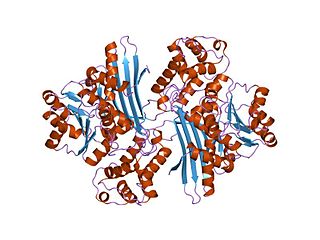Nitrate reductase (NAD(P)H) (EC 1.7.1.2, assimilatory nitrate reductase, assimilatory NAD(P)H-nitrate reductase, NAD(P)H bispecific nitrate reductase, nitrate reductase (reduced nicotinamide adenine dinucleotide (phosphate)), nitrate reductase NAD(P)H, NAD(P)H-nitrate reductase, nitrate reductase [NAD(P)H2], NAD(P)H2:nitrate oxidoreductase) is an enzyme with systematic name nitrite:NAD(P)+ oxidoreductase. This enzyme catalises the following chemical reaction

In molecular biology, the protein domain Saccharopine dehydrogenase (SDH), also named Saccharopine reductase, is an enzyme involved in the metabolism of the amino acid lysine, via an intermediate substance called saccharopine. The Saccharopine dehydrogenase enzyme can be classified under EC 1.5.1.7, EC 1.5.1.8, EC 1.5.1.9, and EC 1.5.1.10. It has an important function in lysine metabolism and catalyses a reaction in the alpha-Aminoadipic acid pathway. This pathway is unique to fungal organisms therefore, this molecule could be useful in the search for new antibiotics. This protein family also includes saccharopine dehydrogenase and homospermidine synthase. It is found in prokaryotes, eukaryotes and archaea.
D-xylose reductase (EC 1.1.1.307, XylR, XyrA, msXR, dsXR, monospecific xylose reductase, dual specific xylose reductase, NAD(P)H-dependent xylose reductase, xylose reductase) is an enzyme with systematic name xylitol:NAD(P)+ oxidoreductase. This enzyme catalyses the following chemical reaction

Chlorophyllide a and Chlorophyllide b are the biosynthetic precursors of chlorophyll a and chlorophyll b respectively. Their propionic acid groups are converted to phytyl esters by the enzyme chlorophyll synthase in the final step of the pathway. Thus the main interest in these chemical compounds has been in the study of chlorophyll biosynthesis in plants, algae and cyanobacteria. Chlorophyllide a is also an intermediate in the biosynthesis of bacteriochlorophylls.





